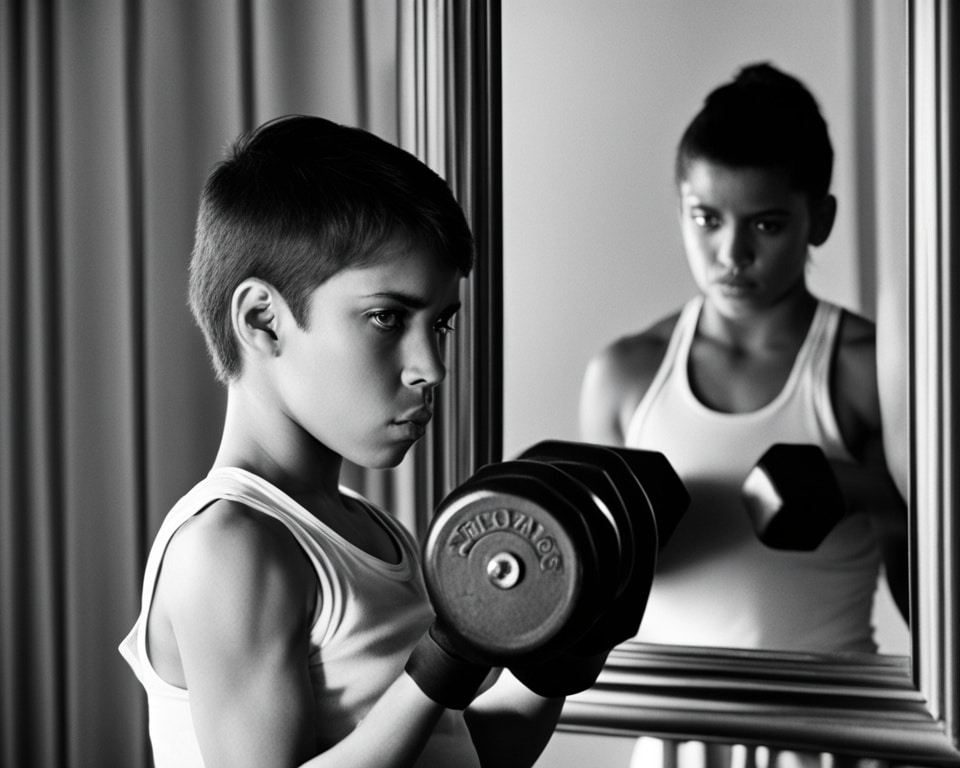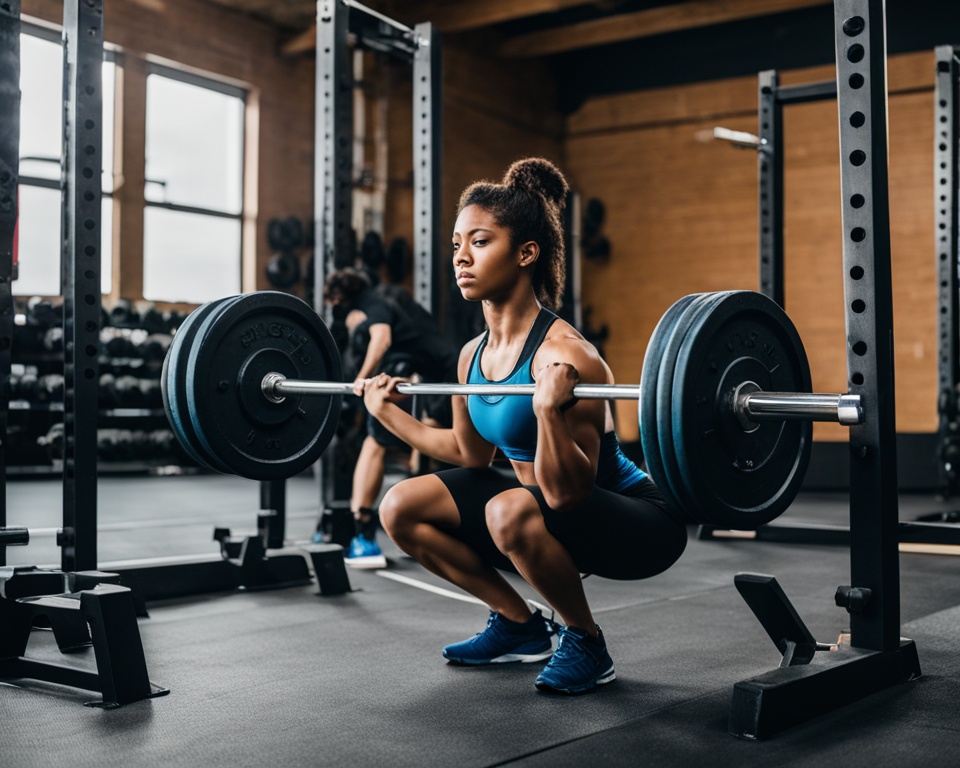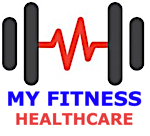Every gym is filled with the sound of weights and a common myth. This myth says, “Weight lifting stunts growth,” especially in young folks. But truth be told: new research says lifting weights doesn’t stop kids from growing taller. Actually, when kids lift weights, it helps the growth hormones work even better. Studies have found that lifting 70-75% of 1RM makes the body produce more GH.
Lifting weights is actually good for kids, opposite to what some people think. Starting strength training early, with an adult watching, is beneficial. It makes muscles stronger and helps kids feel better all around. This wipes away the old myth with solid science.
So, does lifting weights stop growth? No, it doesn’t. It actually helps young athletes to get stronger and grow properly. Working out, including lifting weights, is key for a strong and healthy body at any age.
Key Takeaways
- Scientific evidence indicates that weight lifting benefits growth hormone levels without stunting height.
- Safe weight training can start from a young age and supports increased muscle strength and injury prevention.
- Proper form and supervision are paramount in weight training programs for kids.
- Genetics and nutrition are major factors in growth, with weight lifting supporting, not impeding, these natural processes.
- The American health guidelines suggest that strengthening exercises are integral for children’s weekly activity.
- Strength gains from weight training in youngsters are gradual and contribute to their long-term athletic growth.
Dispelling the Myth: Does Weight Lifting Stunt Growth?
I often hear worries about how weight lifting affects growth. It’s time to clarify: does lifting weights impact height? The answer is no. Experts and studies agree that weightlifting is safe. It doesn’t stop you from growing taller and brings health benefits.
Some sports can hurt growth plates, but not weightlifting. It makes muscles and bones stronger. This helps young athletes avoid injuries. We’re boosting bone and muscle strength in kids, not just making them look good.
Here’s the key: lifting safely and correctly is essential, especially for young people. When it comes to weight lifting and height, there’s no proof that lifting harms growth plates. Young people gain a lot by lifting weights, like stronger bones and less risk of breaking them.

For young athletes, eating right is super important for their growth and how well they do in sports. They need to eat enough calories, with plenty of proteins and calcium. Following a good strength training plan can make them 12 percent stronger in two months.
- Strength training should be twice a week to work well.
- Training four times a week can really boost strength in kids and teens.
- Kids and teens don’t get as bulky as adults, because they have different hormone levels.
Anabolic hormones like testosterone get a boost from lifting weights. These hormones help with growth and building muscle. It’s about getting stronger and better coordinated, not just bigger. The American Academy of Pediatrics and the American Orthopaedic Society for Sports Medicine say that youth fitness should include both strength and weight training.
Powerlifting and Olympic-style weightlifting might not be best for kids because of the risk of injuries. But there are many other ways to train that improve muscle coordination and strength.
| Training Aspect | Recommended Practices | Expected Outcomes |
|---|---|---|
| Strength Training Frequency | 2-4 sessions per week | 9-12% strength increase over two months |
| Technique and Muscle Group Focus | Full range of motion, correct form before adding weights | Improved muscle coordination, less chance of getting hurt |
| Nutrition and Supplementation | Healthy diet full of energy, protein, and nutrients, no steroids | Safe growth, avoiding health problems |
A good fitness plan includes more than just lifting weights. It should have aerobic exercises that work all major muscle groups. Taking enough rest in between is also key. Start without weights and focus on moving correctly and safely through the whole exercise.
Understanding Growth Plates and Weight Lifting
As a mentor focused on young athletes, it’s key to explain growth plates and their role in bone and body growth. Before we explore how weight lifting affects these plates, let’s define them clearly.
What Are Growth Plates and Their Functions?
Growth plates, or epiphyseal plates, are crucial for bone growth in kids. They are found at the ends of long bones. These plates help bones lengthen and shape a child’s height during their growing years.
These plates work hard during adolescence. They eventually harden into strong bones as a child matures.
How Weight Lifting Affects the Growth Plates in Adolescents
There’s a big question about weight lifting and growth plates during puberty. Despite myths, weight training and growth plates work well together when done right. During these important years, weight lifting and bone development can improve strength safely.
Kids as young as 7 or 8 can start strength training with the right approach. They should learn proper form and understand the rules for safe lifting. With adult guidance, young athletes can do simple exercises that boost their sports skills without hurting their bones.
To show how it helps, let’s note some key points:
- Children can do muscle and bone exercises safely every day.
- It’s vital to rest muscles between workouts for growth and healing.
- Studies show that lifting weights makes bones stronger and improves strength, which helps kids stay healthy and fit in the future.
Also, regular strength training can increase IGF-I levels, which is good for bone growth, without affecting height growth. Even young kids, as young as six, can train safely if they follow the proper safety tips.
This shows us that weight lifting and bone development actually support each other. With rest, the right technique, and guidance, weight training is beneficial for health and sports abilities.
In my role, I stress the need for patience. Quick results are not the goal. Over time, kids will see their muscles get stronger and their endurance improve. This careful approach to weight lifting helps protect growth plates, guiding kids to reach their best physical shape during and after puberty.
Gauging the Risks: Safety Precautions for Youth Weight Training

I always say that proper supervision in youth weightlifting is key. It’s a must-have. More kids, aged 6 to 17, are joining gyms. This is great for youth fitness. However, they need wise advice. The National Strength and Conditioning Association (NSCA) says that safe strength training for adolescents is good for both body and mind.
Some worry about weight lifting and growth hormones. Yet, research is comforting. The NSCA has found that correct resistance training is okay for kids. It makes them stronger and helps in sports. It even prevents sports injuries. The key is to focus on safe exercises and wait until after puberty for heavy lifting.
Keeping kids safe while lifting is critical. Here’s a simple rule: aim for 60 minutes of exercise a day, and always under an adult’s watch. This ensures safe strength training for adolescents. It also helps them stay healthy and skilled for life. Below, see a table about the importance of safety and nutrition in youth weightlifting:
| Aspect | Recommendation | Benefit |
|---|---|---|
| Physical Activity | Daily 60 minutes | Reduces chronic disease risk |
| Nutrition | 0.8–1.2g protein/lb body weight | Supports muscle repair |
| Rest | Adequate sleep | Limits appetite surge |
| Training Intensity | Vigorous exercise 45-minute sessions | Higher post-workout calorie burn |
Strong trees grow from strong roots. This is true for young athletes too. By guiding them with a disciplined routine, we prepare them for great success. This impacts their health and sports achievements.
Research on Weight Lifting and Bone Development in Young Athletes
Strength training is crucial for young athletes, not just for lifting weights. It plays a big part in their overall growth. Research shows it’s safe and offers big health perks. Studies, like one by Faigenbaum et al. (2002), show kids who train regularly get physically stronger. This proves strength training is beneficial for children.
Evidence Supporting Safe Strength Training
Resistance training for kids is proven safe by science. Conroy et al. (1993) found it boosts bone density in junior Olympic weightlifters. Gorostiaga et al. (1999) found it doesn’t affect growth negatively. Instead, it boosts strength and endurance in young handball players.
Long-term Health Benefits of Adolescent Strength Conditioning
Discussing adolescent strength training means looking at its long-term perks. A 2007 study by Liao et al. found resistance exercises help kids with mild spastic diplegia. Strength training suits different needs, showing its wide uses.
It’s not one-size-fits-all, as Ramsay et al. (1990)’s research on prepubescent boys shows. My method is about creating well-rounded programs. They improve both physical skills and mental growth. This ensures weight lifting helps young athletes achieve their dreams.
Research on Weight Lifting and Bone Development in Young Athletes
Is it true that weight lifting stunts growth in adolescents?
No, that’s not true. Studies show that lifting weights doesn’t stunt growth. When done right and safely, it’s good for young people.
Can engaging in weight lifting affect the balance of growth hormones in young athletes?
Weight lifting, when done right, doesn’t mess up growth hormones. It actually helps build strong bones and muscles.
At what age is it considered safe for adolescents to start weight lifting?
Kids can start lifting weights at 8 safely, with an adult watching. The focus should be on learning to do it right, not lifting heavy.
What are the actual effects of weight lifting on growth during adolescence?
If a young person lifts weights the right way and safely, it can make their bones stronger. It can also make them more coordinated and less likely to get hurt playing sports.
Does lifting heavier weights correlate with height in young lifters?
No, lifting heavy doesn’t mean you won’t grow tall. Young people who lift safely, without going too heavy, can still grow normally.
Should adolescents avoid certain types of weight lifting to prevent height issues?
Young people should wait until they’re older to lift the heaviest weights. Instead, lift lighter weights more times. This keeps their growing bones safe and helps them grow evenly.
What Are Growth Plates and Their Functions?
Growth plates are the soft parts of kids’ bones where they grow. These plates decide how tall a person will be.
How Weight Lifting Affects the Growth Plates in Adolescents
Lifting weights safely doesn’t harm these growth plates. This means kids can grow tall and have healthy bones.
What are the key safety precautions for adolescents when weightlifting?
It’s important to pick exercises that are right for their age. They also need an adult watching, to do it right, and to not rush into lifting too much.
How does proper supervision in youth weightlifting ensure safety?
Having an adult watch means kids lift the right way, with weights they can handle. This keeps them safe from getting hurt.
What evidence supports safe strength training in youth?
Studies say safe strength training is good. It makes kids more agile, perform better in sports, and have stronger bones. And it doesn’t stop them from growing.
Are there long-term health benefits of adolescent strength conditioning?
Yes, strength training is great long-term. It helps build muscle, make bones denser, and keeps the metabolism healthy. It also helps avoid getting too heavy and the health problems that come with it.

